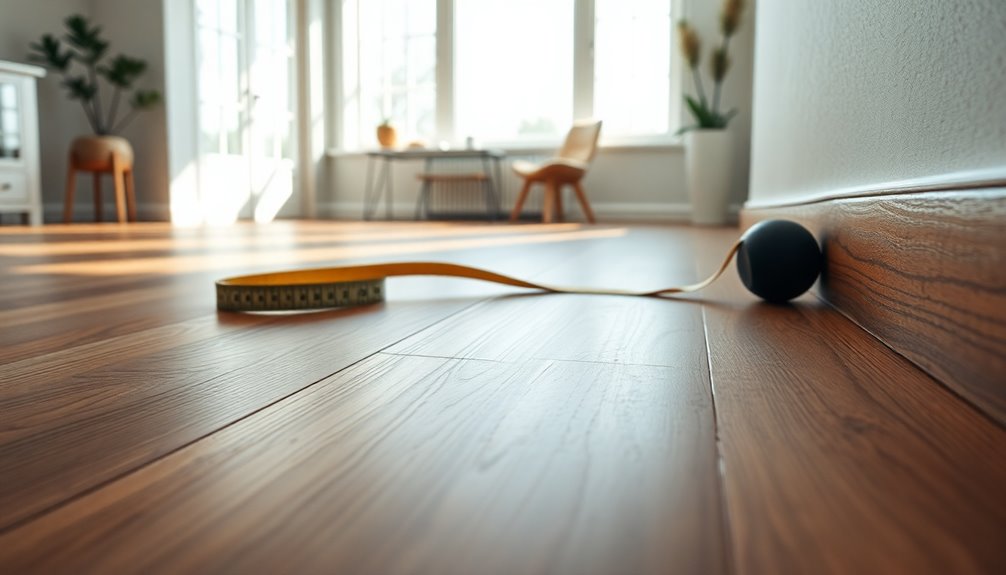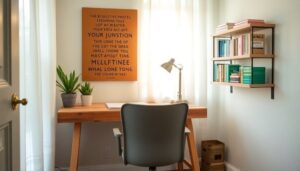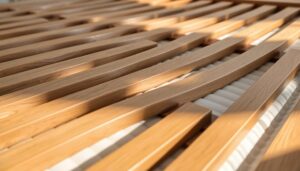Floors in your house should slope no more than ½ to 1 inch per 20 feet. This range indicates no major structural issues. If your floors slope more than 2 inches, it could signal serious foundation problems, and you should get an inspection right away. Regular checks help you identify moisture damage or other concerns early on, saving you from costly repairs later. If you find uneven areas, consider leveling options like shimming or reinforcing joists. Understanding these guidelines keeps your home's structure sound and your finances secure. There's more you can explore about managing these potential issues.
Understanding Floor Slope Norms
When considering how much a floor should slope, you might wonder what the acceptable norms are. Generally, a slope of ½ to 1 inch per 20 feet is seen as acceptable and typically doesn't indicate significant structural issues. However, expense management apps can assist homeowners in budgeting for potential repairs. Additionally, implementing clear payment terms can help ensure that you have the funds available when needed.
However, if you notice your floor slopes more than 2 inches, that could signal serious foundation problems, and it's prudent to schedule an inspection immediately. Intentional sloping may be used for drainage, especially in areas where water tends to accumulate. Still, it's crucial to keep an eye on any changes in the original slope measurements, as these shifts can reveal underlying structural concerns.
Uneven floors can be a red flag, often accompanied by other warning signs like cracks in the wall or even water damage. Addressing these issues early can save you from hefty repair costs down the line. If you find yourself struggling with uneven floors or noticing any of these warning signs, don't hesitate to bring in a professional to assess the situation.
Understanding floor slope norms is critical in maintaining your home's structural integrity and preventing further complications. Additionally, being aware of the importance of timely payments can help ensure you have the financial resources to manage any necessary repairs.
Causes of Floor Sloping
Sloping floors can often indicate deeper structural issues within your home. When you notice sloping or sagging floors, it's vital to investigate further. Common causes include foundation issues that can arise from differential settlement, particularly in older homes. As foundations naturally settle over time, it can lead to uneven floors, posing significant structural problems. Utilizing expense tracking tools can help you budget for necessary repairs. Additionally, effective investment tracking tools can provide insights into how to allocate funds for these repairs.
Moisture damage is another key factor. Leaks or excessive humidity can weaken the floor joists and beams, compromising their integrity. If your home has crawl spaces, inadequate ventilation can exacerbate moisture issues, leading to rot and further weakening of load-bearing components. Regular monitoring can help mitigate these risks and ensure the safety of your home.
Environmental factors like soil creep can also play a role, shifting the stability of your foundation. This movement can create additional pressure on the structural elements of your home, causing noticeable slopes. To catch these issues early, regular inspections are essential. By evaluating the structural integrity of your home, you can identify potential problems before they escalate. Implementing streamlined bookkeeping processes can also help you manage repair costs effectively.
Understanding the causes of sloping floors will help you take the necessary steps to maintain a safe and stable living environment.
Repair Options for Sloped Floors
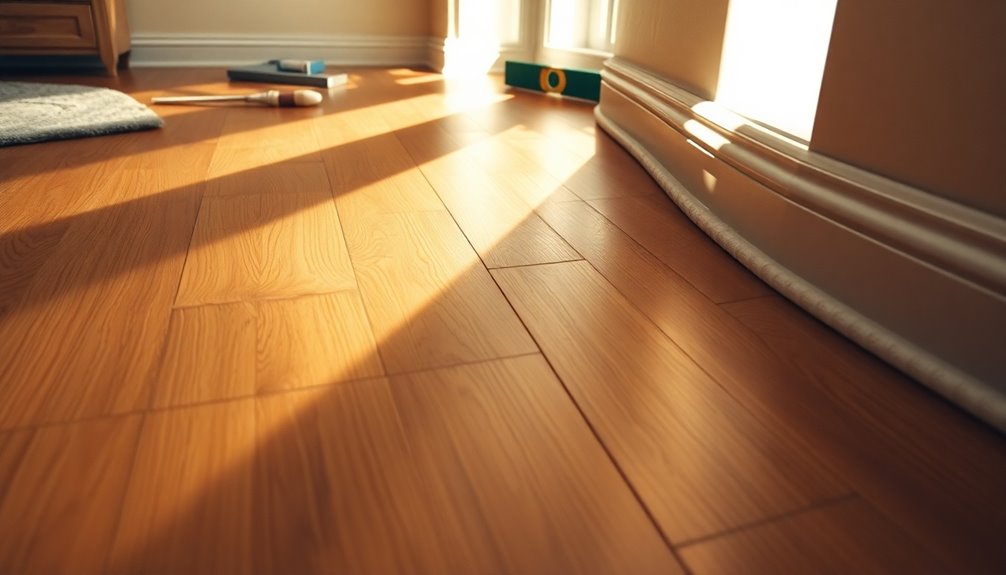
Several effective repair options exist for addressing sloped floors, depending on the severity of the issue. If your sloped floor has a slope exceeding 2 inches, it may indicate serious structural damage.
Start by identifying uneven areas using a carpenter's or laser level, which will help you diagnose the root cause of the unevenness. Utilizing savings calculators can also aid in budgeting for these repairs by providing accurate projections of costs involved. Additionally, assessing your needs for expense tracking apps can help manage repair budgets effectively.
Common repair options include leveling the flooring, which often involves reinforcing existing structures like joists and beams. You might also consider installing shims to adjust support posts, helping to restore balance to the floor.
It's important to hire an expert for any structural repairs, especially if your home features wooden floors, as these repairs can be labor-intensive and may require temporary supports. Regular monitoring of your floors can prevent further deterioration and minimize future repair costs. If you notice foundation shifts or other warning signs, addressing these issues promptly is crucial.
Additionally, utilizing budget apps can empower homeowners to allocate funds effectively for necessary repairs and maintenance.
Costs Associated With Floor Repairs
Addressing sloped floors often leads to significant repair costs, which can vary widely based on the severity of the damage. For instance, if you need slab lifting, you might spend around $2,000, but if the damage is extensive and requires complete floor joist replacements, costs could exceed $20,000.
In old homes, you may face additional structural problems that drive up expenses. Effective budgeting can help you save for these unexpected repair costs, as it provides a structured framework for managing finances and preparing for emergencies. Sill plate repairs typically run between $100 and $120 per linear foot, while sistering floor joists can cost $12 to $14 per foot. If you need a center beam replacement, expect to pay between $245 and $305 per foot, plus any extra for temporary support jacks.
Shim replacements for leveling support posts can cost about $110 per column, and installing adjustable floor jacks usually ranges from $515 to $630.
Moreover, major foundation repairs, which often address the underlying issues causing floor sloping, can average around $7,000. If moisture barriers are needed, that could add another $5,000.
It's essential to assess these costs carefully to avoid unexpected financial strain during repairs. Additionally, having a clear understanding of your financial health can help prioritize necessary repairs and ensure you are prepared for such expenses.
Importance of Professional Inspections
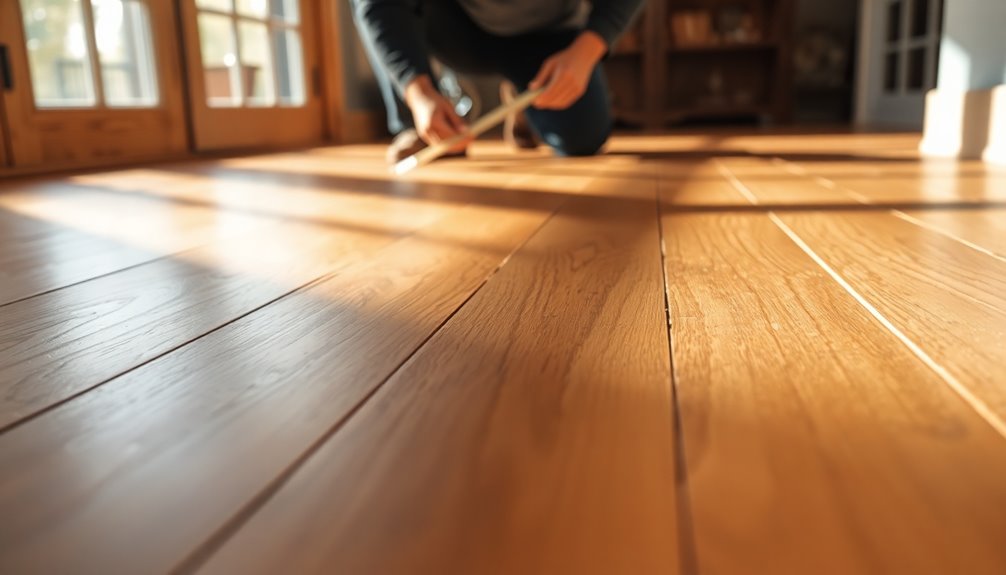
When it comes to maintaining your home, professional inspections play an essential role in identifying floor sloping issues. These inspections are critical for evaluating the extent of any sloping and can uncover underlying structural issues that might lead to costly foundation repairs. A qualified inspector uses specialized tools to accurately measure floor slopes, guaranteeing deviations from the acceptable range of ½ to 1 inch per 20 feet are documented. Additionally, utilizing budget management tools can help you manage repair costs effectively and avoid financial strain. Understanding whether your floor sloping is a symptom of significant foundation problems or just an older home's characteristic is important. This clarity can help you gauge the stability of your home and determine if immediate action is necessary, potentially saving you from future financial burdens. Furthermore, leveraging zero-based budgeting can enable you to allocate funds specifically for unexpected home repairs. Additionally, utilizing automated notifications can help you manage repair timelines effectively and ensure timely actions are taken.
Engaging a structural engineer during the inspection process is also recommended. Their expertise provides informed recommendations for repairs, helping you avoid costly mistakes.
Conclusion
In the grand tapestry of your home, sloped floors weave a tale that shouldn't go unnoticed. Just like a ship needs a level deck to sail smoothly, your house deserves balanced floors to thrive. By understanding the norms and addressing the causes, you can steer clear of costly repairs. So, don't wait for the storm to hit—get a professional inspection and guarantee your foundation remains as solid as a rock, keeping your home safe and sound.

